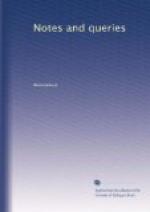* * * * *
COLD HARBOUR
Mr. Editor,—In examining the Ordnance Survey of Kent, I was quite surprised at the recurrence of the name “Cold Harbour;” and again, in Wyld’s Map of London in 1550.
I believe the point has been explained before, but perhaps some of your readers could give some information as to its origin.
G.H.B.
Nov. 8. 1849.
[The Society of Antiquaries was a good deal occupied, we scarcely know whether we may say interested, in the question raised by our correspondent, during the last session: and considerable {61} information upon the subject will be found in the published Proceedings of the Society, and in the last part of the Archaeologia. We should like to know whether there are Cold Harbours in every county in England. Mr. Hartshorne published a long list in his Salopia Antiqua. If our correspondents can give us any addition to that list, they will be acceptable. We are aware that there are several in Kent.]
* * * * *
STATISTICS OF THE ROMAN CATHOLIC CHURCH.
Mr. Editor,—If any reader of your valuable and much-needed periodical can, through its medium, supply me with the title of some recent and authentic work containing Statistics of the Roman Catholic Church—e.g. the number of its members, or reputed members, in the different European States; the number and temporalities of its sees, clergy, &c.—he will confer on me a great obligation; one which it will be a pleasure to me to repay to some other “Querist,” should it lie within my power to supply any desired information, in my turn. Your faithful servant,
E.E.
* * * * *
INCUMBENTS OF CHURCH LIVINGS.
Sir,—perhaps some of the readers of your useful publication could inform me where I can find the name and birth-place of incumbents of church livings prior to 1680, and the patrons of them. Your well-wisher,
L.
* * * * *
THE CURSE OF SCOTLAND—WHY IS THE NINE OF DIAMONDS SO CALLED?
I shall be obliged to any of your correspondents who will inform me why the Nine of Diamonds is called the curse of Scotland. I have heard two causes assigned. One, that the Duke of Cumberland, on the field after the battle of Culloden, wrote upon the back of this card a very cruel and inhuman order for the destruction of the persons and property of the rebels. This cannot be true, for I have in my possession a print entitled “Britons Association against the Pope’s Bulls.” In it the young Pretender or prince is represented attempting to lead across the Tweed a herd of bulls laden with curses, excommunications, indulgences, &c. &c. &c. On the ground before them lies the Nine of Diamonds. This print is dated Oct. 21. 1745, some months previous to the battle of Culloden.




